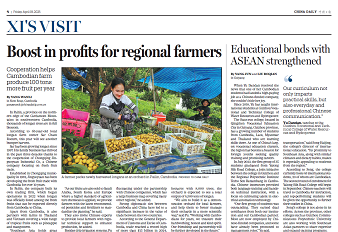Guizhou's forestry industry sees robust growth

Chishui city is one of China's three counties and cities with a bamboo planting area exceeding 1 million mu. [Photo/ddcpc.cn]
According to a recent report, Southwest China's Guizhou province has seen rapid progress in forestry industry development, especially in bamboo plants, tea-oil trees, Chinese prickly ashes and Chinese honeylocust fruits.
By the end of 2020, Guizhou had planted 4.75 million mu (316,666.67 hectares) of bamboo plants, 3.12 million mu of tea-oil trees, 1.19 million mu of Chinese prickly ashes and 690,000 mu of Chinese honeylocust fruits.
The province's forestry industry helped 725,000 people to increase their incomes in 2020, including 530,000 impoverished people.
In 2020, Guizhou produced 250,000 metric tons of bamboo shoots and cut 800,000 tons of bamboo. The province had four counties and cities with bamboo forest coverage above 500,000 mu and more than 420 bamboo processing companies producing about 300 products in six categories.
Guizhou's tea-oil tree output value was 4.02 billion yuan ($622.15 million) in 2020. The province has 25 tea-oil tree processing companies with 26 brands, as well as 10 counties and districts with tea-oil tree planting areas above 200,000 mu.
The province produced 53,800 tons of fresh Chinese prickly ashes in 2020, worth 1.84 billion yuan. It has eight counties and districts with Chinese prickly ash planting areas above 50,000 mu and 279 processing companies producing Chinese prickly ash oil, Chinese prickly ash powder and dried Chinese prickly ash.
Guizhou's Zhijin county in Bijie is the largest Chinese honeylocust fruit processing and distributing center in China. The county has a total Chinese honeylocust fruit planting area of 300,000 mu.
Guizhou has 95 Chinese honeylocust fruit processing companies contributing 440 million yuan of output value in 2020, a 10 percent increase from 2019.
All rights Reserved. 京ICP备13028878号-8







 Overview
Overview Guiyang
Guiyang Guian New Area
Guian New Area Liupanshui
Liupanshui Anshun
Anshun Qianxinan
Qianxinan Qiandongnan
Qiandongnan Qiannan
Qiannan Zunyi
Zunyi Tongren
Tongren Bijie
Bijie Guizhou commits to culture preservation and rural vitalization
Guizhou commits to culture preservation and rural vitalization Guizhou voice at 2025 national two sessions
Guizhou voice at 2025 national two sessions Meet the 'genius moms' at Shenzhen cultural fair
Meet the 'genius moms' at Shenzhen cultural fair 

